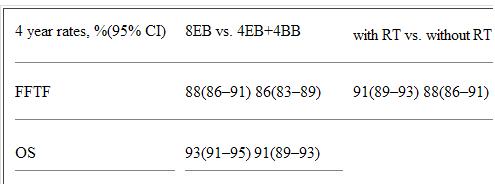Konference: 2006 48th ASH Annual Meeting - účast ČR
Kategorie: Maligní lymfomy a leukémie
Téma: Simultaneous session: Hodgkin Lymphoma: Castleman Disease
Číslo abstraktu: 099
Autoři: Prof. MD Andreas Engert; Jeremy Franklin; Rolf Peter Mueller; MD Hans Theodor Eich; Axel Gossmann; Hans Konrad Mueller-Hermelink; Thomas Cerny; MUDr. Jana Marková; Prof.MD Anthony D. Ho, PhD, FRCP; MD Lothar Kanz; MD Richard Greil, Ph.D.; MD Wolfgang Hiddemann; Beate Pfistner; MD Volker Diehl
The preceding trial HD9 had shown a significant superiority for escalated BEACOPP (EB) for failure-free survival (FFTF) and overall survival (OS) over COPP/ABVD or baseline BEACOPP (BB) (each 8 cycles). HD12 aimed to de-escalate chemotherapy by comparing 8 cycles EB with 4 cycles EB plus 4 cycles BB, with or without consolidatory 30 Gy radiation (RT) to initial bulky and residual disease. A total of 1661 patients aged 16-65 with HL in stage IIB (large mediastinal mass and/or E-lesions) or stage III-IV were randomised from 9/1999-1/2003 according to a factorial design between: 8EB + RT, 8EB no RT, 4EB+4BB + RT, 4EB+4BB no RT. A central diagnostic panel reviewed CT images after completion of chemotherapy independent of randomisation arm, and prescribed RT in selected cases. In the fifth analysis of HD12 (5/2006), 94% of all 1593 eligible randomised patients were evaluable, including 1498 for the chemotherapy comparison and 1449 for the radiotherapy comparison. Patient characteristics were very similar for all 4 arms. Radiation was given in arms with planned RT in 65%, in arms with no planned RT in 10%. 93% of all patients reached a complete remission, 2.2% suffered early progression, 4.6% relapsed and 8.2% died with a median folllow-up time of 48 months. Death due to acute toxicity was 3.2% (sepsis, cardiac, pulmonary, infection), with 21 such deaths in the 8EB arms and 27 in the 4EB+4BB arms. Secondary neoplasias were observed in 55 patients (3.7%): 14 AML/MDS, 12 NHL and 29 solid tumors/others. Four-year Kaplan-Meier estimates for arm pairs according to the factorial design were:

No significant differences were observed when comparing treatments according to the sequential analysis plan (N.B. 10% received RT in arms without RT). The final analysis, scheduled when 80% of patients have 5 years follow-up, must be awaited before final conclusions can be drawn.
Datum přednesení příspěvku: 10. 12. 2006
